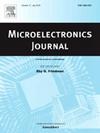基于遗传算法的SAR adc电容失配校正方案
IF 1.9
3区 工程技术
Q3 ENGINEERING, ELECTRICAL & ELECTRONIC
引用次数: 0
摘要
提出了一种基于遗传算法的电容失配标定算法。该算法以模数转换器(ADC)的有效位数(ENOB)为优化目标,将电容失配问题转化为优化问题,并采用遗传算法进行求解。此外,还设计了一种高能量效率的电容式逐次逼近寄存器(SAR) ADC电路。电容式数模转换器(CDAC)采用交叉数字结构,从布局上进一步减少了电容失配。为了验证电容失配校准方案,我们在采用55纳米CMOS工艺设计的时间交错ADC的312.5 MS/s 6位子ADC上进行了实验。实验结果表明,在输入频率为150.146 MHz时,ENOB为5.23位,SFDR为46.7dBc。最后,为了验证该方案在高精度SAR adc中的有效性,开发了一个14位行为模型进行实验。实验结果表明,ENOB为13.2位,提高了2.1位。本文章由计算机程序翻译,如有差异,请以英文原文为准。
A genetic algorithm-based capacitor mismatch calibration scheme for SAR ADCs
This paper proposes a capacitor mismatch calibration algorithm based on genetic algorithms. The algorithm takes effective number of bits (ENOB) of the analog-to-digital converter (ADC) as the optimization objective, transforms the capacitor mismatch problem into an optimization problem, and solves it using the genetic algorithm. Moreover, a high-energy-efficiency capacitive successive approximation register (SAR) ADC circuit is designed. The capacitive digital-to-analog converter (CDAC) adopts an interdigitated structure, which further reduces capacitor mismatch from the layout aspect. To verify the capacitor mismatch calibration scheme, we conducted experiments on a 312.5 MS/s 6-bit sub-ADC of a time-interleaved ADC designed with a 55-nm CMOS process. The experimental results show that at an input frequency of 150.146 MHz, the ENOB is 5.23 bits and the SFDR is 46.7dBc. Finally, to validate the effectiveness of the proposed scheme for high-precision SAR ADCs, a 14-bit behavioral model was developed to conduct experiments. The experimental results demonstrate an ENOB of 13.2 bits, achieving an improvement of 2.1 bits.
求助全文
通过发布文献求助,成功后即可免费获取论文全文。
去求助
来源期刊

Microelectronics Journal
工程技术-工程:电子与电气
CiteScore
4.00
自引率
27.30%
发文量
222
审稿时长
43 days
期刊介绍:
Published since 1969, the Microelectronics Journal is an international forum for the dissemination of research and applications of microelectronic systems, circuits, and emerging technologies. Papers published in the Microelectronics Journal have undergone peer review to ensure originality, relevance, and timeliness. The journal thus provides a worldwide, regular, and comprehensive update on microelectronic circuits and systems.
The Microelectronics Journal invites papers describing significant research and applications in all of the areas listed below. Comprehensive review/survey papers covering recent developments will also be considered. The Microelectronics Journal covers circuits and systems. This topic includes but is not limited to: Analog, digital, mixed, and RF circuits and related design methodologies; Logic, architectural, and system level synthesis; Testing, design for testability, built-in self-test; Area, power, and thermal analysis and design; Mixed-domain simulation and design; Embedded systems; Non-von Neumann computing and related technologies and circuits; Design and test of high complexity systems integration; SoC, NoC, SIP, and NIP design and test; 3-D integration design and analysis; Emerging device technologies and circuits, such as FinFETs, SETs, spintronics, SFQ, MTJ, etc.
Application aspects such as signal and image processing including circuits for cryptography, sensors, and actuators including sensor networks, reliability and quality issues, and economic models are also welcome.
 求助内容:
求助内容: 应助结果提醒方式:
应助结果提醒方式:


